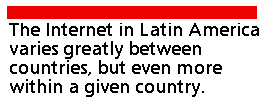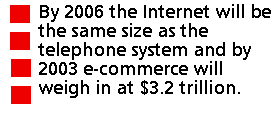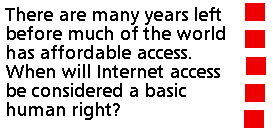This is my first report for First Monday, and I' d like to tell you a bit where I live, besides in front of a screen. I live in an over-priced forty year old housing tract, built during the boom years in California after World War II, when most of San José was covered with fruit orchards. Much of the time I work at home. The rest of the time I travel for speeches or visits to distant capitals, to rural areas and other Internet Free Zones.
Here at home I have many choices for connectivity. Pacific Bell and TCI cable pass by my house. I'm in an area covered by Metricom's Ricochet wireless services. My Internet connection is a 150 kb/sec spread spectrum wireless link 25 kilometers from a tower in Fremont. Many people are connected to the Internet here in San José, a city larger than San Francisco and one that bills itself as the capital of Silicon Valley. Because of the wealth of such firms as Intel, Cisco and now eBay, our county accounts for more dollar value produced than any other county in the United States. This area is at the center of high tech job creation. If you go to a movie theater, you will see ads before the main feature for companies hoping to hire ASIC engineers, Web designers, or just skilled technicians. Billboards advertise jobs for skilled people, and unskilled also have a big choice, but housing is so costly that service people are living further and further from Silicon Valley. This, in turn, exacerbates the traffic problems which are not expected to improve in the future, even with the infusion of billions of dollars in highway funds. Traffic is the top concern of area residents, in part because money can't buy any more freedom from jams and long commutes. The CEO in her Lexus is stuck in the same lane as the restaurant worker in his old Datsun.
San José was the location for the June 1999 Internet global summit, held by the Internet Society each year in a city where members and businesses can help defray the multimillion dollar conference expenses and network training sessions. The Internet Society or ISOC began in 1992-93, about the same time as a Nexis database search would yield too many hits for the word "Internet." After that, the term became what database searchers call a 'noise' word. From the very beginning the Internet Society was a forum for technical presentations from academicians and from their counterparts in commerce. It was never a trade show like Interop or Internet World, and it has not grown at the same pace as the Internet has. Over the years, the Board of Trustees has lowered the dues and tried to appeal to visitors from "countries in the early stages of networking." The most significant program, from my point of view, has been the pre-conference workshops for those administrators, technicians, and librarians who receive scholarships (usually) to study the basics of TCP/IP, router configuration, network security, and html using a revolving cadre of instructors who now come from some of the countries that had no connection a few years ago. Beginning last year the workshop for the Latin American and Caribbean students was held within that region. This year was no exception. The workshops for English and French speaking students were in the same city as the main conference.
I helped plan the library track for the workshop that took place in Mérida, Venezuela, a city high in the Andes that seems to have perfect weather. They usually manage to have the tropic rain fall at night, and the temperature varies between cool and warm. The Universidad de los Andes in Mérida has run these workshops since 1993, and many countries now have technical cadres comprised of graduates from these short courses.

When I look at what is happening with the spread of the Internet in other countries in Latin America, it is evident that it varies greatly between countries, but even more within the country. Capitals and regional cities are the first to be connected, with costs of connectivity varying greatly. Consequently, there is a lot of interest in wireless systems such as the one that Dr. Ermanno Pietrosemoli is working on in Mérida. This is a 10 mb/sec state-wide network that is being set up by Spike Technologies of Nashua, New Hampshire. The public library in Mérida has very high-speed access to the Internet in a public room. Charges are low, considering the speed of access. For more details see his paper on the Internet Society conference Web site. Other large cities have ATM networks, fiber rings, and ADSL service on the horizon. Meanwhile, rural areas where population is less dense, where the commercial potential is less, and where even telephone and mass media infrastructure is weak, are not being served in most areas.
One of the other tracks in the course was run by a Costa Rican NGO called Acesso Nacional that provides strategic training for network planners. They used a lot of tools and tactics from community organizing that really involved the participants in a major way. It was good to see that kind of innovation in a technical course.

Oscar Robles, who is the coordinator for the NIC in Mexico, gave an introduction to ICANN, the Internet Corporation for Assigned Names and Numbers, a controversial effort to take over the IP address space allocation, the root server management, and open up the management of it to various stakeholders in the worldwide Internet. At present it is being criticized for a number of reasons, and few people can sort out thevillains, the self-serving, and the crazies from those who are making aneffort to solve some very tough governance problems. This is an example of a very complex set of issues that mix technical, political, cultural, and especially commercial elements.
When the interim board was appointed last year, it seems to reflect the Internet power structure as it was, not as it should be. For instance, nobody from the Spanish speaking world was on the board, and other groups could look at who was at the table and who was not and be rather critical of the board's composition.
Robles was not critical of ICANN, but he urged the other Latin American participants to take part, get involved in order to be heard. However, there are many barriers to becoming engaged. First, most of the deliberations and documents and mailing lists are in English because the meetings are held in that language. In Latin America you have a growing cadre of trained technical people, but many of those do not feel comfortable debating online in a second language. This narrows the participation to a small pool of candidates. Secondly, the meetings around the world (Berlin, Malaysia, Chile) are very expensive to attend. This favors people from large companies, large law firms, content owners, government agencies in Europe and the U.S., and well-endowed universities.
Public participation in the process will not be broad-based. The issues are too complex, and few people have the time to pursue it, important as it is. I liken it to taking part in standards discussion on internal combustion engines when you just want the car to run (or to be easy to service if you are a mechanic).

The Latin Americans are probably better organized than any other regional group, and during the main conference Mike Roberts of ICANN met with a large group of attendees. Though the meeting was held in English, thus making it hard for some to have their voices heard, he did make a strong effort to lay out the ways groups such as this could participate and perhaps have at-large representation on the board.
San José
A contingent of instructors from the Mérida meeting flew here to attend the main conference in the week after the training.
The INET '99 theme was "Internet is for Everyone" a phrase used by Vint Cerf in a previous speech and in an RFC that is on the ISOC Web site. I have been attending this conference since 1993, and it always struck me that the organization was not growing in the same way that the Internet was expanding. One of the reasons is the high cost of the conference. At $600 and up, it is out of reach of most teachers, non-profits, small ISPs, even from the U.S. and Europe. Those attending are either on full scholarship for the network workshops or have the support of some research university or company. It would be good if the price could drop to about $300 for full entry, with more generous admissions policies for those presenting papers. As it stands, it is too costly to have broad-based attendance, even if the annual dues are lowered to $5 for citizens from developing countries.
ISOC is to be commended for putting all the papers online before the conference began. Attendees also received a CD-ROM with all the files. The tracks for the conference include technology (by far the largest), social and legal, and regulatory issues, education, and e-business. It is a difficult process to solicit abstracts, then read through dozens of papers, and decide the program with one or two face-to-face meetings and the rest done by e-mail. Because the program committee met in San José during the year, it was easy for me to take part. Following one planning session colleagues from Santiago, Chile, and Cairo, Egypt, walked out of the hotel in the early evening in search of a restaurant. Both of them asked me where the downtown was located. We were right in the middle of it, but it was so deserted that they could not believe they were in the center of Silicon Valley. I remarked that most of the people were commuting or computing, and yet I felt defensive that we did not have much outdoor night life as so many other world class cities do. People were at home or in their cars. Only when there is a convention does our downtown seem to come alive.
The first event I attended was the one day workshop for countries in the early stages of networking. There were other ones on XML, security, and routing in future networks. Our workshop was planned by Peruvian and Ghanaian members, funded by 3Com, and a helpful Cameroonian provided witty, ad hoc translations from French to English. Attendees continue to request simultaneous translations because so many attending only spoke French.
Vint Cerf made the first of his many appearances (perhaps we should rename it the Vinternet Society) and gave a rundown of the new numbers: 206 countries online, 165 million users, with most in U.S./Canada and about one million in Africa and less than that in the Middle East. By 2006 he believes the Internet will be the same size as the telephone system and by 2003 e-commerce will weigh in at $3.2 trillion. He announced that MCI-Worldcom and Paul Allen are putting $600 million into Metricom to spread and upgrade the wireless Richochet network that is moderately popular in this area, and a few other parts of the U.S. It will be interesting to see if this money revives their prospects.
On June 22 there was a workshop for K-12 teachers that was not well attended. Some felt that so many other education technology conferences were being offered, that this workshop no longer served a real purpose in the United States. On the same day I took a group of Latin Americans to public access centers at the San José Public Library and the Digital Clubhouse to show them examples of government funded and non-profit community technology centers. We had planned to visit the Weird Stuff Warehouse which is filled with tons of older computer hardware and software, but we ran short of time and decided to visit the temple of new electronics products: Fry's Electronics, where each store has some outrageous design motif. The Campell store, nearest to the conference center, looks like an Egyptian tomb, with Office 2000 being displayed by a mummy, and a huge table of laptops resting on the backs of two large black panthers. DVD movies blasted from the crypt/audio demo room. The prices are low, but the huge selection gives some of us a headache, and it is hard to cover the whole place in an hour. Several of the visitors returned to make purchases such as Corel Suite, Palm Pilots, a blood pressure device, a Toshiba digital camera, and even a Star Wars figure.
The next day the main conference began. It is still a gathering place for a lot of old and new Internet talent. Katie Hafner of the New York Times was finishing an article on Usenet, when I mentioned a statistic I had heard in one of the classes in Mérida. This intrigued her, and we walked over to the opening session of the conference and found the instructor in the middle of the audience. She spoke with the reporter, elaborating on what I provided. Just-in-time experts!
Opening ceremonies usually have a local politician dropping by to say "welcome." Mayor Ron Gonzales of San José is the first Latino mayor of a big town in this state since the Spanish left early in the 19th century. The mayor worked for Hewlett-Packard in education before taking office, and I thought he would have talked more about learning, but he concentrated on e-commerce and the big companies located here: eBay, Cisco, and Adobe. The crowd was interested in e-commerce, but most members do not come from that part of the Internet. The city is planning a massive e-government effort, but it is not yet underway. He claimed that 40% of our population is employed in high tech in this town.
There were so many papers, and they are all online, so I won't try to detail the content. However, a couple struck me as particularly relevant. Kenneth Cukier's "Bandwidth Colonialism: The Implications of Internet Infrastructure on International E-Commerce" looks at the effects of the Internet as a de facto star network (with the U.S. at the center) and the problems of other countries overcoming this to grow e-commerce initiatives locally. Kim Veltman's paper on "Digital Reference Rooms: Access to Historical and Cultural Dimensions of Knowledge" was supplemented by a fascinating look at the way culture has been represented though the ages and the challenges of having a common interface that also allows for local diversity in design.
I worked part of the time in the exhibit area where a dozen or so firms had set up booths, displays, and even VR demos running live over Internet II. Tachyon, for whom I consult, was demonstrating its high-speed, two-way Internet connection via a new satellite managed by Satmex. Many people from developing countries, as well as other telecom companies came by for a visit and a chat. A consultant from Ghana came by to talk about a telecenter being built outside of Accra by the American song writer, Isaac Hayes. The head of the only ISP in one of the world's most remote countries, Bhutan, came by with colleagues from Bangladesh and India. Listening to their stories about lack of access and the high prices they have to pay indicates that there are many years left before much of the world has affordable access. In his keynote Floyd Bakes of 3Com wondered when access would be considered by many to be a basic human right.
As I look back on this and previous INET conferences, I think the multiple tracks on very different themes have been both a strength and a weakness. No other conference has so many different viewpoints about the Internet and its future. Others are focused on privacy, e-commerce, security, Web design, or education. Unfortunately, many people are attending the specialized conferences in greater numbers, but INET attendance has been low. Possibly, with the formation of the Internet Social Task Force, more people will find the Society and its conferences as important meeting places for exchange of ideas and for action. The board finally has two members from developing countries (Thailand and Egypt), and another new board member, John Gage of Sun Microsystems, is interested in equitable access around the world. Let's hope this continues to be a major focus for the Society and its members.
Next year, INET 00 will be in Yokohama, Japan. July 18-21.
About the Author
Steve Cisler is a consultant whose background is in public and special libraries. He has been a teacher in the Peace Corps, a wine maker and search and rescue coordinator in the Coast Guard. Now he focuses on public access projects and community computing projects in the United States and developing countries. He is currently working with Tachyon, Inc., an Internet services carrier using Ku band satellite for high speed access. He has written for Online, Database, American Libraries, Library Journal, and Wired. Steve has two sons and lives with his wife in San José, California.
E-mail: cisler@pobox.com


Copyright © 1999, First Monday